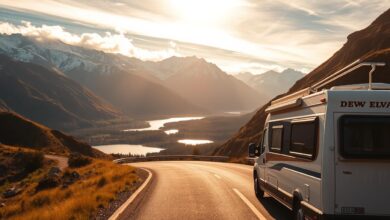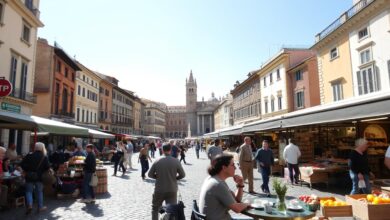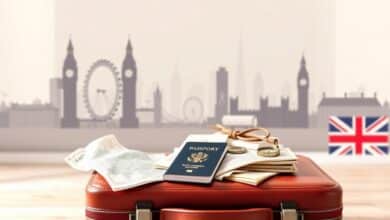How to Plan a Cross-Country Trip Across Canada: A Travel Prep Guide
Starting a cross-country trip in Canada is thrilling and needs careful planning.
Anúncios
This guide is your key to exploring Canada’s varied landscapes and cultures. With the right tools, your trip will be smooth and filled with unforgettable moments.
It covers everything from geography to budgeting and top sights. This guide is perfect for all kinds of travelers.
Knowing Canada’s regions, cultures, and travel tips makes your journey easy. You’ll enjoy your experiences more. Let’s explore the key parts of planning your dream Canadian trip.
Understanding Canada’s Geography and Culture
Canada is a vast country with diverse geography and rich culture. Travelers exploring Canada will find six major regions, each with its own features and attractions. Knowing these unique regions makes travel more enjoyable and helps appreciate Canada’s culture and customs.
You will be redirected to another website
Major Regions and Their Unique Features
Canada is divided into six main regions:
- Atlantic Canada: Famous for its stunning coastlines, quaint fishing villages, and green landscapes.
- Quebec: A cultural center with French roots, offering historic cities, delicious food, and lively arts.
- Ontario: Home to Toronto’s vibrant city life and the breathtaking Niagara Falls, it’s a hub of diversity.
- The Prairies: Known for its vast farmlands, this area shows off the beauty of open skies and welcoming communities.
- British Columbia: Famous for its mountains, outdoor activities, and growing wine region.
- The North: Rich in natural beauty, it offers a peek into Indigenous cultures and untouched wilderness.
Cultural Diversity and Local Customs
Canada’s culture is shaped by Indigenous heritage and immigrant stories. This diversity is seen in local customs across regions. Festivals, food, and crafts show how different cultures blend, making Canada special. Visitors are encouraged to dive into these customs to make their trip richer.
Essential Language Tips
Knowing the local language helps when talking to people. Canada has two official languages: English and French. Learning basic phrases in both can help connect with locals and make interactions better.
Setting Your Travel Budget
Creating a travel budget is key for a smooth trip across Canada. By planning your expenses, you can enjoy your journey without breaking the bank. This guide covers the basics of a travel budget, including where to stay, daily costs, and tips for saving on food and activities.
Estimating Travel Costs
When planning your trip, think about transportation, lodging, meals, and activities. The main costs are:
- Transportation: This includes flights, train tickets, or gas for driving.
- Accommodations: Look up prices for hotels, hostels, or vacation rentals.
- Daily expenses: Plan for food, fun, and any outings you might take.
A travel planner app can help track your spending and keep you on budget.
Accommodation Options and Prices
In Canada, you can find everything from cheap hostels to fancy hotels. Knowing the average prices for different places to stay helps you choose wisely. Here’s a look at what you might pay for different types of accommodations:
| Accommodation Type | Average Price (per night) |
|---|---|
| Hostel | $20 – $50 |
| Mid-range Hotel | $80 – $150 |
| Luxury Hotel | $200+ |
| Airbnb | $60 – $250 |
Budget-Friendly Tips for Food and Activities
There are ways to save money on food and fun. Here are some tips:
- Check out local markets for cheap meals and fresh food.
- Find free or cheap spots like parks and museums.
- Look for happy hour deals at restaurants for cheaper eats.
- Use multi-visit passes for attractions to cut down on costs.
Best Time to Visit Canada
Choosing the right time to visit Canada makes your trip better. You can enjoy activities and weather you like. Each season in Canada has its own special moments, from skiing in winter to spring’s flower festivals.
Seasonal Highlights and Events
Canada’s different areas have their own highlights. In winter, the Rocky Mountains are perfect for skiing. Spring brings vibrant flower festivals in Vancouver.
Summer is filled with music festivals in Toronto and Montreal. Autumn is known for its stunning fall colors, especially in Quebec.
Weather Considerations for Travelers
Knowing the weather is key when planning your trip. Winter can be very cold in the north, but Vancouver is milder. Here’s a table showing average temperatures in major cities during peak months:
| City | Winter (Dec-Feb) | Spring (Mar-May) | Summer (Jun-Aug) | Fall (Sep-Nov) |
|---|---|---|---|---|
| Toronto | -2°C to 2°C | 5°C to 15°C | 20°C to 30°C | 10°C to 20°C |
| Vancouver | 0°C to 5°C | 5°C to 15°C | 15°C to 25°C | 10°C to 20°C |
| Montreal | -10°C to -5°C | 0°C to 10°C | 18°C to 28°C | 5°C to 15°C |
| Quebec City | -12°C to -8°C | -1°C to 8°C | 15°C to 25°C | 5°C to 15°C |
Peak vs. Off-Peak Travel
Travelers should think about peak and off-peak seasons. Peak seasons are lively but can be expensive and crowded. Off-peak travel might be cheaper and less crowded, offering a more relaxed trip.
Knowing these differences helps you choose the best time for your visit, based on what you want and your budget.
Creating an Itinerary
Planning a travel itinerary for Canada needs careful thought. It’s important to pick places that show off the country’s beauty and lively cities. Must-see spots include Banff National Park, Toronto, Montreal, and Quebec City.
Top Destinations to Include in Your Trip
- Banff National Park: Known for breathtaking landscapes and outdoor activities.
- Toronto: A vibrant city offering diverse cultural experiences and attractions.
- Montreal: Famous for its unique blend of European charm and modern flair.
- Quebec City: A historical gem with rich French heritage and picturesque views.
Suggested Travel Routes Across Canada
Using an itinerary builder helps plan routes that highlight Canada’s beauty. The Trans-Canada Highway is a great choice, connecting provinces with stunning views. For nature lovers, the Icefields Parkway and Cabot Trail are perfect.
Flexibility in Travel Plans
Being flexible in travel plans makes the trip better. Taking spontaneous detours or local tips can lead to unforgettable moments. An adaptable itinerary lets travelers dive deep into each place’s culture and adventure.
Transportation Options
Traveling across Canada needs careful thought about how to get around. You can choose between flying fast or taking a scenic drive. Each way has its own benefits. Knowing the difference between flying and driving can change how you see Canada’s beauty.
Also, you might want to try public transport or rent a car. These options give you freedom to explore different places.
Flying vs. Driving Across Canada
Flying is quick for covering long distances in Canada. Cities like Toronto, Vancouver, and Montreal are easy to reach by plane. It saves time and gets you to different provinces fast.
Driving, however, lets you see Canada’s stunning views up close. Road trips reveal hidden spots and encourage you to stop and enjoy the scenery. It makes your trip unforgettable.
Public Transport Alternatives
If you don’t want to drive, public transport is a good choice. Canada has trains and buses that connect cities well. Via Rail offers a scenic train ride.
In cities, buses and subways make it easy to get around. They’re great for last-minute plans.
Renting a Vehicle for Flexibility
Renting a car gives you the freedom to plan your trip your way. You can choose from cars or SUVs to fit your needs. It lets you explore places you might not find on a map.
This option makes your trip more personal. You can go wherever you want, whenever you want. It’s perfect for seeing Canada’s hidden gems.
| Transportation Option | Pros | Cons |
|---|---|---|
| Flying | Fast travel between major cities | Limited scenic views |
| Driving | Scenic routes and flexibility | Longer travel times |
| Public Transport | Cost-effective and convenient in cities | Limited access to remote areas |
| Renting a Vehicle | Greater access to various locations | Additional costs for rental and insurance |
Accommodations in Canada
Travelers in Canada will find many places to stay. There are fancy hotels in cities and cozy B&Bs in the countryside. Knowing what’s out there can make your trip better.
Types of Lodging Available
Canada has several types of places to stay:
- Hotels: These range from fancy to simple.
- Motels: Found near highways, they’re cheap and quick.
- Bed and Breakfasts: Run by families, they feel like home.
- Hostels: Perfect for saving money, with shared rooms.
- Airbnb: Find unique places like homes or rooms.
Booking Hotels and Places to Stay
Booking hotels is easier with some planning. Think about where you are, what you need, and what others say. Websites and apps help you find the best deals and places to stay.
Unique Stays: Hostels, B&Bs, and Airbnb
Looking for something different? Try hostels, B&Bs, or Airbnb. Hostels are lively, B&Bs are personal, and Airbnb offers homes and cabins. They fit all kinds of travelers and budgets.
Experiences Not to Miss
Traveling across Canada offers a wealth of unique experiences. You can explore stunning national parks, vibrant cultural festivals, and exciting culinary adventures. These experiences highlight Canada’s breathtaking landscapes and rich cultural heritage.
From awe-inspiring natural wonders to lively local events, there’s something for everyone. This section covers must-see attractions that make any Canadian adventure unforgettable.
National Parks and Natural Wonders
Canada is famous for its national parks, each with its own unique beauty. Banff and Jasper National Parks in Alberta are known for their majestic mountains and pristine lakes. They offer hiking, wildlife viewing, and photography opportunities.
Niagara Falls is one of Canada’s most iconic natural wonders. It attracts millions with its thundering cascades. Other parks like Yoho and Gros Morne also offer unique ways to connect with nature.
Cultural Festivals and Events
Canada’s cultural festivals celebrate its diverse heritage. The Calgary Stampede is a highlight, showcasing Canadian western culture through rodeos, concerts, and parades. Quebec’s Winter Carnival is another must-see, with ice sculptures and lively entertainment.
Events like the Toronto International Film Festival also showcase Canada’s artistic spirit. They offer a glimpse into the nation’s regional traditions.
Culinary Experiences Across Regions
Exploring Canada’s culinary landscape reveals a variety of flavors. From fresh seafood on the Atlantic Coast to hearty dishes in the Prairies, there’s something for everyone. Iconic dishes like poutine in Quebec and bison burgers in Alberta are a must-try.
Food tours and local markets offer memorable experiences. They capture the essence of each region’s food culture.
Safety Tips for Travelers
Traveling across Canada is full of amazing sights and experiences. But, safety should always be your top priority. Knowing about health and travel insurance, local emergency contacts, and safety tips is key. These steps help make your trip smooth and worry-free.
Health and Travel Insurance
Getting the right travel insurance is crucial. It should cover medical emergencies, trip cancellations, and lost items. Compare different policies to find one that fits your health needs. Good insurance offers peace of mind and protects your wallet from unexpected costs.
Emergency Contacts and Services
Knowing local emergency numbers is a must. In Canada, call 911 for police, fire, and medical help. Also, have a list of nearby hospitals and urgent care centers. This way, you can get help fast if you need it, making your trip safer.
General Safety Precautions
Every traveler should take basic safety steps. These vary by location. In cities, stay alert to your surroundings. In rural areas, watch out for wildlife. Always keep valuables safe and learn about local customs that affect safety. Having reliable emergency contacts also adds to your safety.
Resources for Planning Your Trip
Planning a cross-country trip across Canada is exciting. The right tools make it even better. You need apps and websites to organize your trip and get local tips. A travel planner app can help manage your itinerary.
Apps and Websites for Travel Organization
Many travel apps make planning easy. They let you map out your trip with just a few taps. Websites offer info on places to visit, where to stay, and how to get around. Using these tools makes your trip more enjoyable.
Travel Forums and Social Media Groups
Travel forums and social media groups are great for getting tips from others. You can share and learn about places you’ll visit. It’s a way to get advice that’s not in travel guides.
Local Guides and Tour Operators
Local guides and tour operators offer a real look at Canada. They know the best spots and share their knowledge. With their help, you’ll see more than just sights. You’ll experience the culture and beauty of each place.
FAQ
What is the best way to start planning a trip to Canada?
Start by using a Canada Trip Planner. Identify your interests first. Then, research the major regions and options available. Use travel planning resources to set your budget and look into accommodation and transport options.
How can I create a travel schedule for my Canadian holiday?
Use a travel planner app to create your itinerary. Include top destinations and suggested travel routes. Keep some flexibility for spontaneous opportunities based on local recommendations.
What are the seasonal highlights and events in Canada?
Canada has unique seasonal highlights. Winter sports in the Rockies, spring flower festivals in Vancouver, summer music events, and stunning fall foliage views. Plan your trip by season to experience the most.
Are there budget-friendly accommodation options in Canada?
Yes, Canada offers many budget-friendly options. You can find hostels, bed-and-breakfasts, and vacation rentals on Airbnb. Research prices and book during off-peak times to save money.
What transportation options are recommended for traveling across Canada?
You can fly, rent a vehicle, or use public transport like buses and trains. Each option has its own benefits. Choose based on your priorities for time and experience.
Which national parks should I include in my itinerary?
Don’t miss Banff, Jasper, and Yoho National Parks. They are known for their stunning beauty. Enjoy hiking, skiing, and wildlife watching in these parks.
How can I ensure my trip is safe while traveling in Canada?
Make sure you have health and travel insurance. Learn about local emergency contacts and safety guidelines. This will give you peace of mind during your trip.
Where can I find local guides and travel operators for a more authentic experience?
Check travel forums and social media for local guide recommendations. Engaging with these resources can lead to authentic experiences that deepen your understanding of Canadian culture.
Published on: 12 de April de 2025

Arturo González
Arturo González is the founder and lead writer of DebxCred.com, a platform created to help people make smarter and more informed financial decisions. With a degree in Business Administration and a specialization in Financial Marketing, Arturo built a solid corporate background before deciding to share his knowledge in a practical, easy-to-understand way.
Driven by a genuine passion for finance and education, Arturo turned DebxCred.com into a trusted source for detailed reviews of financial products, digital banking tools, and practical financial education — empowering readers to take control of their money with confidence.
In his free time, Arturo finds balance and inspiration while surfing — a hobby that reflects his calm yet determined approach to helping others build a healthier and more prosperous financial life.






